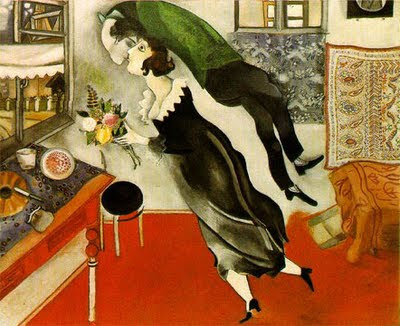Marc Chagall: Painting the great power of love
 |
| L'Anniversaire |
In Japan July 7th is a special day. It is the festival of Tanabata when two celestial starcrossed lovers cross the Milky Way to be together again. This day also marks the birthday of Marc Chagall (1887 - 1985), a painter whose work is appropriately infused with a deep sense of love. It is particularly apt then that this date has been chosen as the culminating day of the extensive exhibition of Chagall's work that opened last week at Ueno's Tokyo Metropolitan Art Museum.
The love in Chagall's paintings is particularly obvious in works like L'Anniversaire (1923), which shows him floating through the air and twisting round to kiss his beloved first wife, Bella, whom he had married 8 years earlier and who continued to inspire him even after her death in 1944. The dreamlike, almost surreal composition of this work perfectly captures the sense of intertwining elation that often accompanies romantic love.
But Chagall's works also include love in a more generalized sense, as in his affection for the people and scenes of his youth in the Belorussian town of Vitebsk and its environs. Elements from this period constantly recur as familiar and cherished motifs even in works painted more than 50 years after he finally left Russia. For example, La chute d'Icare (1974/77), a treatment of the classical myth of Icarus, takes place above a landscape filled with peasants, animals, and rough-hewn log cabins familiar to him from his native Belorussian countryside.
 |
| La chute d'Icare (1974/77) |
"Usually painters expressing this much love end up creating something cloying or sentimental," Hiroshi Matsuda, the exhibition's curator admits. "But Chagall's paintings are not like this."
Matsuda does however admit that the lyrical collection of softer elements -- charming motifs such as flying lovers, animals, and angels, a typically naive style, and radiant colors -- creates a kind of visual aromatherapy. But, in a strange way, the history of the 20th century, in all its brutal inhumanity, has actually been kind to Chagall's art.
Born into a traditional Jewish family, his hometown Vitebsk had a thriving Jewish community that was later destroyed by the twin forces of a Communist revolution insensitive to traditional cultures and a Nazism that saw the Jews as an existential threat. Although many younger viewers, especially here in Japan, may be unaware of these associations when they look at the kind face of the old Jewish man in La Pere (1911) or the Cubist-inspired riot of shapes that mark the Jewish cemetery of Le Cimetiere (1917), the sense that the artist is depicting a vanished world gives his work a poignancy and an undertone of melancholy that creates a perfect balance with the exuberance of motif, color, and the freedom of composition.
 |
| Le Cimetiere (1917) |
"Some art critics have started to feel something is maybe missing from his paintings because his style is always there and his motifs are also limited. So, sometimes people get bored."
Looked at this way, the struggles of his youth, when he experimented with Fauvism, Cubism, Orphism, and Surrealism, is perhaps a more interesting time than his long mature period when he held to a style in which he had developed complete confidence. Also, with age, the atmosphere of his paintings becomes lighter, softer, and more beatified, as the darker undertones give way to a radiant but rather fuzzy sense of universal love sometimes bordering on the platitudinous.
Later works, like the vibrant Le nu mauve (1967) with its playful goat and harlequin remain enchanting, but without the uncertainty of his earlier work, they also lack much of the edge. This reliance on a comfortable, unchanging palette of styles and strategies often gives these mature works the flavor of a delicious stew left simmering just a little too long.
C.B.Liddell
The Japan Times
1st May, 2002




















Post A Comment
No comments :